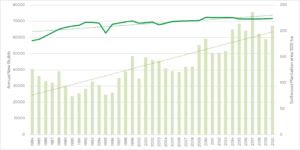ABARES report shows a steep decline in plantation areas – but new trees are needed to tackle climate change and meet structural timber demand.
The Department of Agriculture, Water and the Environment (ABARES) released its latest report on Plantation and log supply earlier this week.
The Victorian softwood estate has remained static since the early 1990s. That is at odds with new house builds that have increased by 66% since 1984, while the softwood estate, which is critical to construction, increased by only 23% over the same timeframe.
“The increasing supply gap between the softwood estate and new builds tells quite a story over time and indicates an urgent need to improve our sovereign construction timber supply capability,” said Deb Kerr, VFPA CEO.
Forestry is committed to supporting the Federal Government in its A billion trees program, but those trees need to go in the ground somewhere – and not all land is created equal. The increasing cost of agricultural land is a major hurdle, which is why Victoria’s Forestry Hubs are looking at options to not only expand our plantation estate but also to use innovative manufacturing solutions to make our available timber go further.
“In the Green Triangle we are actively looking for new opportunities to stop the plantation decline and optimising existing fibre use”, confirms Liz McKinnon, Executive General Manager of the Green Triangle Forest Industries Hub. “The Hub is looking to establish partnerships with farmers – we want to incentivise landowners so they can incorporate commercial tree farming as a new business opportunity”, Ms McKinnon said.
However, the benefits of increasing the plantation estate to close the supply and demand gap are important, the future for our climate depends on more trees in the ground. “If the sector plants one billion new trees nationally over the next ten years, those trees will store an estimated additional 200 megatonnes of carbon dioxide per year by 2050,” said Deb Kerr, CEO at VFPA.
“Sometimes, we look for complicated, expensive options to tackle difficult problems. But in the case of our current climate crisis, part of the solution is right in front of us. Trees remove carbon from the atmosphere and continue to store it for their lifecycle and in the harvested wood, wood fibre and pulp and paper products. More trees equal less carbon dioxide in the atmosphere. The Victorian Government needs to work with all stakeholders to get the right trees in the ground, at right scale and in the right areas,” Ms Kerr concluded.
###
Softwood plantation estate and annual new house builds 1984-2021 (data sources: ABS and ABARES)

Contact:
Deborah Kerr
(m) 0437 559 360
(e)[email protected]
